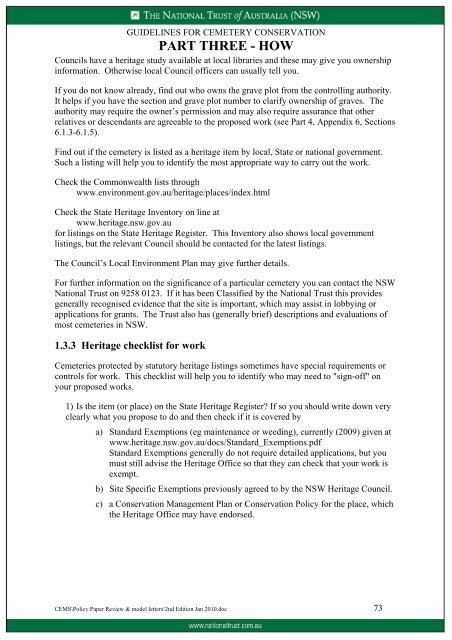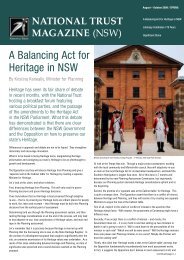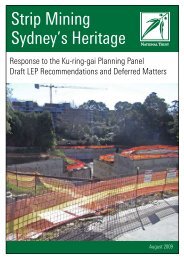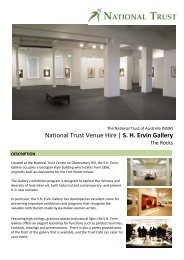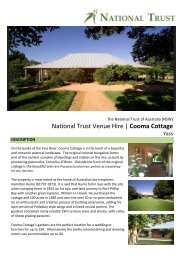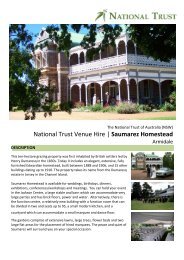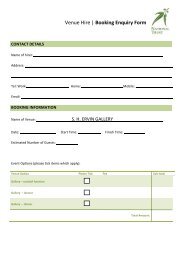Guidelines for Cemetery Conservation - National Trust of Australia
Guidelines for Cemetery Conservation - National Trust of Australia
Guidelines for Cemetery Conservation - National Trust of Australia
You also want an ePaper? Increase the reach of your titles
YUMPU automatically turns print PDFs into web optimized ePapers that Google loves.
GUIDELINES FOR CEMETERY CONSERVATION<br />
PART THREE - HOW<br />
Councils have a heritage study available at local libraries and these may give you ownership<br />
in<strong>for</strong>mation. Otherwise local Council <strong>of</strong>ficers can usually tell you.<br />
If you do not know already, find out who owns the grave plot from the controlling authority.<br />
It helps if you have the section and grave plot number to clarify ownership <strong>of</strong> graves. The<br />
authority may require the owner’s permission and may also require assurance that other<br />
relatives or descendants are agreeable to the proposed work (see Part 4, Appendix 6, Sections<br />
6.1.3-6.1.5).<br />
Find out if the cemetery is listed as a heritage item by local, State or national government.<br />
Such a listing will help you to identify the most appropriate way to carry out the work.<br />
Check the Commonwealth lists through<br />
www.environment.gov.au/heritage/places/index.html<br />
Check the State Heritage Inventory on line at<br />
www.heritage.nsw.gov.au<br />
<strong>for</strong> listings on the State Heritage Register. This Inventory also shows local government<br />
listings, but the relevant Council should be contacted <strong>for</strong> the latest listings.<br />
The Council’s Local Environment Plan may give further details.<br />
For further in<strong>for</strong>mation on the significance <strong>of</strong> a particular cemetery you can contact the NSW<br />
<strong>National</strong> <strong>Trust</strong> on 9258 0123. If it has been Classified by the <strong>National</strong> <strong>Trust</strong> this provides<br />
generally recognised evidence that the site is important, which may assist in lobbying or<br />
applications <strong>for</strong> grants. The <strong>Trust</strong> also has (generally brief) descriptions and evaluations <strong>of</strong><br />
most cemeteries in NSW.<br />
1.3.3 Heritage checklist <strong>for</strong> work<br />
Cemeteries protected by statutory heritage listings sometimes have special requirements or<br />
controls <strong>for</strong> work. This checklist will help you to identify who may need to "sign-<strong>of</strong>f" on<br />
your proposed works.<br />
1) Is the item (or place) on the State Heritage Register? If so you should write down very<br />
clearly what you propose to do and then check if it is covered by<br />
a) Standard Exemptions (eg maintenance or weeding), currently (2009) given at<br />
www.heritage.nsw.gov.au/docs/Standard_Exemptions.pdf<br />
Standard Exemptions generally do not require detailed applications, but you<br />
must still advise the Heritage Office so that they can check that your work is<br />
exempt.<br />
b) Site Specific Exemptions previously agreed to by the NSW Heritage Council.<br />
c) a <strong>Conservation</strong> Management Plan or <strong>Conservation</strong> Policy <strong>for</strong> the place, which<br />
the Heritage Office may have endorsed.<br />
CEMS\Policy Paper Review & model letters\2nd Edition Jan 2010.doc 73


